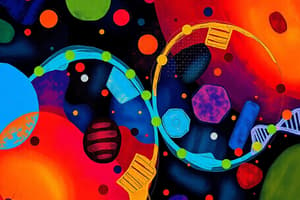Podcast
Questions and Answers
What is the primary purpose of chromosome segregation during cell division?
What is the primary purpose of chromosome segregation during cell division?
- To distribute genetic information equally between daughter cells (correct)
- To break down the nuclear envelope in prometaphase
- To form visible chromosomes in prophase
- To align chromosomes along the equatorial plane in metaphase
Which stage of mitotic cell division involves the breakdown of the nuclear envelope?
Which stage of mitotic cell division involves the breakdown of the nuclear envelope?
- Anaphase
- Metaphase
- Prometaphase (correct)
- Prophase
What is the role of microtubules from spindle fibers in mitotic cell division?
What is the role of microtubules from spindle fibers in mitotic cell division?
- Distributing genetic information between daughter cells
- Attaching to kinetochores at the centromeres in prophase (correct)
- Aligning chromosomes along the equatorial plane in metaphase
- Breaking down the nuclear envelope in prometaphase
In which stage of mitotic cell division do chromosomes align along the equatorial plane called the metaphase plate?
In which stage of mitotic cell division do chromosomes align along the equatorial plane called the metaphase plate?
What would happen if chromosomes were not distributed equally between daughter cells during cell division?
What would happen if chromosomes were not distributed equally between daughter cells during cell division?
What is the role of cohesin cleavage during anaphase in mitosis?
What is the role of cohesin cleavage during anaphase in mitosis?
What occurs during telophase of mitosis?
What occurs during telophase of mitosis?
What can happen if chromosomes are not properly attached to spindle fibers during mitosis?
What can happen if chromosomes are not properly attached to spindle fibers during mitosis?
What unique processes are involved in chromosome segregation during meiosis?
What unique processes are involved in chromosome segregation during meiosis?
How do cells ensure accurate chromosomal transmission from parent to child cell?
How do cells ensure accurate chromosomal transmission from parent to child cell?
Flashcards are hidden until you start studying
Study Notes
Cell Division: Unraveling Chromosome Segregation
Cells divide to grow, repair themselves, and maintain their numbers throughout our bodies. This process is essential for life, and it wouldn't function without careful coordination of chromosome segregation. Let's delve into this critical aspect of cell division.
Chromosomes, which carry genetic information, need to be distributed equally between daughter cells during cell division; otherwise, we might end up with half-human, half-banana hybrids! The primary types of cell division—mitosis and meiosis—split chromosomes differently depending on whether they produce genetically identical (somatic) offspring or sexually reproducing gametes.
Mitotic Cell Division
Mitosis ensures accurate duplication and distribution of DNA among two new somatic cells. It consists of five distinct stages: prophase, prometaphase, metaphase, anaphase, and telophase. In each stage, specific proteins responsible for proper alignment and movement of chromosomes play crucial roles:
- Prophase: Chromatin condenses into visible chromosomes containing sister chromatids joined at the centromere. Microtubules from spindle fibers begin attaching to kinetochores located at the centromeres.
- Prometaphase: Nuclear envelope breaks down, and chromosomes move towards microtubule poles.
- Metaphase: Chromosomes align along the equatorial plane called the metaphase plate due to motor protein activity pulling them there. This positioning allows precise separation later in anaphase.
- Anaphase: Sister chromatids separate through cohesin cleavage at the centromeric region and attachments break free from kinetochore-microtubule connections. Each pole receives one copy of every chromosome.
- Telophase: Daughter nuclei form around separated chromosomes, and nuclear envelopes reappear. Finally, cytokinesis cuts the cytoplasm in two, completing mitosis.
During mitosis, chromosomes must be properly attached to spindle fibers before separating. If this doesn't happen correctly, it can lead to various issues such as polyploidy, trisomy, or monosomy — conditions like Down Syndrome or Turner Syndrome result from improperly aligned chromosomes leading to uneven distribution during cell division.
Meiotic Cell Division
Meiosis involves producing four unique haploid gamete cells through two rounds of cell division. During the first round (meiosis I), homologous chromosomes pair up and exchange genetic material through crossing over. Then, after homologous chromosomes separate, sister chromatids still connected by cohesions also split apart during the second round (meiosis II).
Meiosis has its own version of chromosome segregation, including unique processes such as synapsis, chiasmata formation, and crossing over. These events help shuffle genes across homologous chromosomes and ultimately create more diverse offspring in sexual organisms.
In conclusion, understanding how cells precisely distribute genetic material through chromosome segregation provides fundamental knowledge necessary for learning about human development, disease, and evolution. Cells employ sophisticated mechanisms involving many specialized proteins to ensure accurate chromosomal transmission from parent to child cell, ensuring continuity and diversity within living systems.
Studying That Suits You
Use AI to generate personalized quizzes and flashcards to suit your learning preferences.





